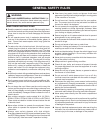
4
Do not use near underground electric cables, telephone
lines, pipes, or hoses. If in doubt, contact your utility or
telephone company to locate underground services.
Make sure your extension cord is in good condition.
When using an extension cord, be sure to use one heavy
enough to carry the current your product will draw. A wire
gauge size (A.W.G.) of at least 14 is recommended for an
extension cord 50 feet or less in length. A cord exceed-
ing 100 feet is not recommended. If in doubt, use the
next heavier gauge. The smaller the gauge number, the
heavier the cord. An undersized cord will cause a drop in
line voltage resulting in loss of power and overheating.
Start the cultivator carefully according to instructions from
a normal operating position and with feet well away from
the tines. Do not force cultivator. It will do the job better
and with less likelihood of a risk of injury at the rate for
which it was designed.
Stay alert. Watch what you are doing. Use common sense.
Do not operate cultivator when you are tired.
If the unit strikes a foreign object, stop the motor, thor-
oughly inspect the machine for any damage, and repair
the damage before restarting and operating the ma-
chine.
Never leave the operating position when the motor is
running.
Unplug the unit before unclogging the tines and when
making any repairs, adjustments, or inspections.
Do not overload the machine capacity by cultivating too
deep in a single pass or at too fast a rate.
SPECIFIC SAFETY RULES
Be aware that the equipment may unexpectedly bounce
upward or jump forward if the tines should strike buried
obstacles such as large stones, roots, or stumps.
Never operate the equipment on a slope.
Use extreme caution when pulling the machine towards
you.
When not in use, cultivator should be stored indoors in a
dry, locked up place — out of the reach of children.
Maintain cultivator with care. Keep tines clean for best
performance and reduce the risk of injury. Follow instruc-
tions for lubrication and changing accessories. Inspect
cultivator cord periodically and, if damaged, have it
replaced. Keep handles dry, clean, and free from grease
and oil.
Check damaged parts. Before further use of this cultivator,
a guard or other part that is damaged should be care-
fully checked to determine that it will operate properly
and perform its intended function. Check for alignment
of moving parts, binding of moving parts, breakage of
parts, mounting, and any other condition that may af-
fect its operation. A guard or other part that is damaged
should be properly repaired or replaced by an authorized
service center unless otherwise indicated elsewhere in
this manual.
Save these instructions. Refer to them frequently and
use them to instruct others who may use this cultivator. If
you loan someone this unit, loan them these instructions
also.
WARNING:
Some dust created by power sanding, sawing, grinding, drilling, and other construction activities contains chemicals
known to cause cancer, birth defects or other reproductive harm. Some examples of these chemicals are:
• lead from lead-based paints,
• crystalline silica from bricks and cement and other masonry products, and
• arsenic and chromium from chemically-treated lumber.
Your risk from these exposures varies, depending on how often you do this type of work. To reduce your exposure to
these chemicals: work in a well ventilated area, and work with approved safety equipment, such as those dust masks
that are specially designed to filter out microscopic particles.


















